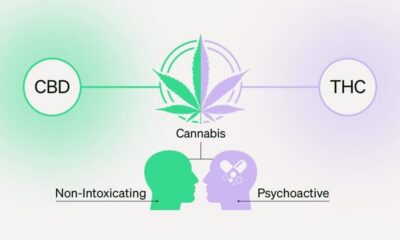Education
Camp Lejeune Water Contamination: Why It Should Matter to Everyone

Image link: https://pixabay.com/photos/contamination-water-pollution-lake-4286704/
It can be seriously disturbing to wake up one day just to find out that the water you and your loved ones have been consuming has been tainted with pollutants, posing severe health risks. This isn’t a far-fetched scenario. It’s the unfortunate reality that unfolded at Camp Lejeune, a military base in North Carolina.
While the immediate impact was felt by those directly affected, the significance of the Camp Lejeune water contamination incident extends far beyond the base’s borders. In this blog post, we’ll explore why this matter should grab everyone’s attention, even if you’re not directly impacted by it.
From health concerns and environmental consequences to legal ramifications and the power of community support, this blog tries to explain why the Camp Lejeune water contamination incident matters to each and every one of us.
Health Risks Beyond Camp Lejeune
The health risks stemming from the Camp Lejeune water contamination incident extend well beyond the immediate vicinity of the base. Contaminants such as volatile organic compounds (VOCs) and toxic chemicals found in the water supply have been linked to a range of severe health conditions. These include increased rates of various cancers, neurological disorders, reproductive issues, etc.
The United States Department of Veterans Affairs highlighted many health conditions associated with the Camp Lejeune incident. Some of the most severe ones include different types of cancer, multiple myeloma, female infertility, neurobehavioral effects, and non-Hodgkin’s lymphoma, among others.
Being aware of these health conditions will empower the unaffected ones to steer clear of contaminated water and frequently check their water sources for the presence of any pollutants. As a result, it becomes easier to ensure a healthy society, thus a healthy and developed nation.
The impact of such incidents is not limited to those who resided or worked at Camp Lejeune but also affects their families and offspring, highlighting the transgenerational implications of the contamination. It was later discovered that pregnant women who consumed contaminated water at the camp later delivered children with various health complications.
Thus, when you understand the health risks associated with this incident, you can identify potential patterns and learn valuable lessons about environmental safety and public health. The case of Camp Lejeune serves as a cautionary tale, reminding all of us of the urgent need for stringent regulations, proactive monitoring, and timely disclosure of potential water contaminants in all communities.
Environmental Consequences
The water contamination incident at Camp Lejeune had profound environmental consequences, leaving a lasting impact on the surrounding ecosystem. This is because of the hidden chemicals that seeped into the groundwater, threatening both public health and the environment.
The U.S. government has found four major contaminants in Camp Lejune water. The substances involved are trichloroethylene (TCE), perchloroethylene (PCE), benzene, and vinyl chloride. The presence of hazardous chemicals had detrimental effects on various aspects of the environment along with posing severe health risks.
Trichloroethylene (TCE)
TCE, one of the chemicals found in the Camp Lejeune water supply, has been shown to infiltrate soil and groundwater, leading to potential contamination of nearby water sources. The contamination endangers aquatic ecosystems, disturbing the fragile equilibrium of marine life and potentially inflicting lasting damage on both plants and animals.
Perchloroethylene (PCE)
The presence of Perchloroethylene (PCE) in the Camp Lejeune water supply has raised concerns about soil and groundwater contamination. PCE can seep into the soil, persisting over time and potentially harming plant life. This contamination poses risks to local ecosystems, disrupting natural processes and potentially impacting biodiversity.
Along with harming the environment, both TCE and PCE are known to be harmful to health. Research indicates that exposure to TCE and PCE can lead to adverse health outcomes such as cancer and congenital abnormalities.
Benzene
Benzene, a hazardous chemical released into the environment at Camp Lejeune, poses significant ecological risks. It can contaminate soil, air, and water, endangering the well-being of both terrestrial and aquatic organisms. The release of benzene into the environment can disrupt natural ecological balances, potentially leading to adverse effects on local flora and fauna.
Plus, benzene is a health hazard as proved by many studies. Scientific studies have established a correlation between benzene exposure and various health concerns, including an increased risk of miscarriages and the development of multiple myeloma.
Vinyl Chloride
Vinyl Chloride, another chemical present in the Camp Lejeune water contamination incident, poses environmental hazards. It has the potential to contaminate soil and groundwater, which can, in turn, impact local ecosystems and endanger plant and animal life. The release of vinyl chloride into the environment raises concerns about the overall health and sustainability of affected ecosystems.
Vinyl Chloride is also not good for health. In fact, studies have linked exposure to vinyl chloride to health conditions like liver cirrhosis, cancer, and other complications.
Legal and Financial Ramifications
The Camp Lejeune water contamination incident carries significant legal and financial ramifications that extend beyond the immediate affected individuals. The repercussions of this disaster have implications for society as a whole.
One major aspect is the legal landscape surrounding the contamination. Lawsuits and legal actions have been initiated against the responsible parties, seeking justice for those impacted by the contaminated water. These legal battles aim to hold accountable those responsible for the inadequate handling and disclosure of the contamination, as well as to secure compensation for the victims.
The financial burden resulting from the Camp Lejeune water contamination is another critical aspect. The costs associated with medical treatments, healthcare expenses, and long-term care for affected individuals can be overwhelming.
Plus, the economic impact reaches beyond individual households, as communities and businesses suffer from decreased property values and potential liabilities related to the contamination incident.
Thus, by filing a Camp Lejeune water contamination lawsuit, victims are seeking fair compensation and bringing to the fore government’s negligence in the case. Such actions will spread awareness about the ins and outs of the incidents, which is likely to enable both the government and the public to take action to prevent similar incidents in the future.
As of May 2023, the Navy has yet to reach settlements for approximately 45,000 claims connected to the water contamination issue at Camp Lejeune, according to TorHoerman Law. This is despite the fact that President Biden signed a bill nine months ago, aimed at establishing a procedure for addressing health claims of veterans.
Hence, if you or your loved ones are vicitms of this incident, you need to quickly file a lawsuit with the help of a competent lawyer. Any delays can further bring down the possibility of the desired outcome.
Share Knowledge and Raise Awareness
Sharing knowledge about the Camp Lejeune water contamination incident and raising awareness about its implications is crucial for everyone, regardless of direct impact. Through the process of acquiring knowledge and spreading awareness, you can cultivate a shared comprehension of the seriousness of the situation.
Increasing awareness about the incident helps shed light on the experiences of veterans, their families, and civilian personnel who have been affected by the incident. It empowers you to empathize with their problems and advocate for their rights to justice and compensation.
However, the official information regarding the incident is not accessible to everyone and often gets delayed due to red tapism. Those affected discover the incident’s implications either by accident or by doggedly fighting a legal battle. To demand action for the victims, U.S. Senator Marco Rubio, a Republican from Florida, drew attention to the issue of water contamination at Camp Lejeune by writing a letter to Secretary of the Navy, Carlos Del Toro.
In the letter, Senator Rubio expressed deep concern regarding the large volume of claims, approximately 60,000, filed by veterans, their families, and civilian personnel affected by the Camp Lejeune water contamination. Of utmost concern is the fact that these claims have not been reviewed by the Navy as of yet.
This recent development highlights the need for increased awareness and action to ensure that these claims receive proper attention and consideration.
Community Support and Solidarity
Community support and solidarity are essential when it comes to the Camp Lejeune water contamination incident. Even if you are not directly impacted, showing empathy and standing in solidarity with those affected can make a significant difference in their lives.
Supporting the Camp Lejeune community means recognizing the hardships they have endured and acknowledging the ongoing challenges they face. By coming together as a collective, you can provide emotional support, amplify their voices, and advocate for their rights to justice, healthcare, and compensation.
Through community support, you can encourage others to join in supporting the affected individuals and their families. Through collective efforts, you can promote healing, restoration, and a shared commitment.
When you offer community support and stand in solidarity, you not only provide much-needed assistance to those impacted by the incident but also foster a culture of compassion, empathy, and social responsibility. Together, you can build a stronger community that advocates for justice, supports those in need, and works towards a healthier and safer environment for all.
Increased Awareness Can Help Prevent Similar Incidents in the Future
The Camp Lejeune water contamination incident holds significant importance for everyone, irrespective of direct impact. By understanding the health risks, environmental consequences, legal and financial ramifications, and the power of community support, you realize the broader implications of such incidents.
One crucial takeaway is that increased awareness plays a vital role in preventing similar incidents from occurring. By sharing knowledge, raising awareness, and demanding better regulations and transparency, you can contribute to safeguarding the well-being of communities and preventing the devastating consequences of water contamination.
Education
Romasha Nath: A Rising Star Making Her Mark

Introduction
The name Romasha Nath has been gaining attention across various circles, sparking curiosity about the person behind this distinctive moniker. While information about prominent figures often floods the internet, some individuals capture interest through their unique contributions and growing influence in their respective fields.
Understanding the journey of emerging personalities like Romasha Nath offers valuable insights into how modern professionals navigate their careers and build their reputations. Whether you’re researching for academic purposes, professional networking, or general curiosity, exploring the backgrounds of influential individuals can provide inspiration and learning opportunities.
This comprehensive overview examines the life, career, and contributions of Romasha Nath, offering readers a detailed look at her background, achievements, and the impact she has made in her field.
Early Life and Educational Foundation
The formative years of any successful individual often provide crucial context for understanding their later achievements. Romasha Nath’s educational journey appears to have laid a strong foundation for her professional endeavors, though specific details about her early life remain limited in public records.
Like many professionals who later achieve recognition, her educational background likely played a significant role in shaping her career trajectory. The combination of academic preparation and personal drive often creates the perfect conditions for future success.
Career Development and Professional Growth
Romasha Nath’s career path demonstrates the modern approach to professional development, where individuals often navigate multiple opportunities to build expertise and establish their reputation. Her professional journey reflects the changing landscape of career advancement in contemporary society.
The evolution of her career showcases how dedicated professionals can build meaningful contributions through consistent effort and strategic positioning within their chosen field. Her approach to career development offers lessons for other aspiring professionals seeking to make their mark.
Notable Contributions and Achievements
Every influential figure leaves their mark through specific contributions that set them apart from their peers. Romasha Nath’s work appears to have resonated within her professional community, though the full scope of her contributions continues to develop.
Her achievements reflect the dedication and expertise that characterize successful professionals across various industries. The recognition she has received suggests that her work has made a meaningful impact on those within her sphere of influence.
Recognition and Professional Standing
Professional recognition often serves as a barometer for measuring an individual’s impact and contributions. While comprehensive information about specific awards or formal recognition for Romasha Nath remains limited, her growing visibility suggests that her work has not gone unnoticed.
The professional community’s awareness of her contributions indicates that she has successfully established herself as a noteworthy figure within her field. This recognition often comes through peer acknowledgment, professional networks, and the quality of work produced over time.
Influence and Future Potential
The lasting impact of any professional extends beyond immediate achievements to encompass the broader influence they have on their field and community. Romasha Nath’s growing recognition suggests that her influence continues to expand as her career progresses.
Her trajectory points toward continued growth and potentially greater recognition as she builds upon her existing foundation. The early indicators of success often predict future achievements for dedicated professionals who maintain their commitment to excellence.
The ripple effects of her work may inspire others within her field and contribute to broader developments in her area of expertise. This type of influence often becomes more apparent over time as the full scope of an individual’s contributions becomes clear.
Frequently Asked Questions
Who is Romasha Nath?
Romasha Nath is an emerging professional who has gained recognition within her field, though comprehensive public information about her background remains limited.
What is Romasha Nath known for?
She appears to be gaining recognition for her professional contributions, though specific details about her primary areas of work are not widely documented in public sources.
Where can I find more information about Romasha Nath?
As with many emerging professionals, information may be available through professional networks, industry publications, or official professional profiles.
What makes Romasha Nath notable?
Her growing recognition within professional circles suggests that her work has made meaningful contributions to her field, though specific achievements may not be widely publicized yet.
Building Recognition in the Digital Age
The story of Romasha Nath reflects broader trends in how professionals build recognition and establish their reputations. Her journey demonstrates that success often comes through consistent effort, quality work, and strategic professional positioning.
For those inspired by emerging success stories like hers, the key lessons involve dedication to one’s craft, building professional relationships, and maintaining high standards in all endeavors. These foundational elements create the conditions for long-term professional growth and recognition.
As Romasha Nath’s career continues to develop, her story serves as a reminder that meaningful professional contributions often begin with individual dedication and grow through community recognition and peer acknowledgment.
Education
NIV vs NLT: Which Bible Translation Is Right for You?

Introduction
Choosing the right Bible translation can feel overwhelming with dozens of options available. Two of the most popular modern translations are the New International Version (NIV) and the New Living Translation (NLT). Both aim to make Scripture accessible to contemporary readers, but they take different approaches to achieve this goal.
The niv vs nlt seeks to balance accuracy with readability through a thought-for-thought translation method. Meanwhile, the NLT prioritizes clarity and natural expression, often paraphrasing complex passages to ensure understanding. Each version serves different purposes and audiences, making the choice between them an important consideration for your Bible study journey.
Understanding the strengths and characteristics of each translation will help you make an informed decision that aligns with your reading goals, whether you’re new to Scripture or deepening your theological study.
History and Translation Philosophy
The New International Version (NIV)
The NIV project began in 1965 when the Christian Reformed Church and National Association of Evangelicals recognized the need for a contemporary English Bible translation. Over 100 scholars from various denominations and countries worked for more than a decade to complete the original NIV, published in 1978.
The translation committee employed dynamic equivalence, also called thought-for-thought translation. This approach focuses on conveying the meaning and intent of the original text rather than providing word-for-word translations. The scholars aimed to create a Bible that maintained theological accuracy while using natural, contemporary English.
The NIV underwent a major revision in 2011, incorporating advances in biblical scholarship and archaeological discoveries. This updated version also addressed concerns about gender-inclusive language where appropriate to the original text.
The New Living Translation (NLT)
The NLT has its roots in The Living Bible, a paraphrase created by Kenneth Taylor in 1971. However, the NLT represents a complete retranslation from the original Hebrew, Aramaic, and Greek texts rather than a revision of Taylor’s work.
Published in 1996, the NLT was created by a team of 90 Bible scholars who prioritized clarity and readability above all else. The translation philosophy leans heavily toward dynamic equivalence, sometimes crossing into paraphrase territory to ensure modern readers can easily understand the text.
The NLT team focused on producing a Bible that reads naturally in English, even if it meant departing significantly from the structure and phrasing of the original languages. A second edition was released in 2004, and further updates have continued to refine the translation.
Accuracy and Readability
NIV: Balancing Precision and Accessibility
The NIV maintains a strong commitment to accuracy while making the text accessible to modern readers. Translators carefully considered manuscript evidence and consulted leading biblical scholars to ensure theological precision. The translation generally stays close to the original text structure while smoothing out passages that might confuse contemporary audiences.
Reading level assessments typically place the NIV at a 7th to 8th-grade level, making it accessible to most adults and older children. The language flows naturally without sounding overly academic or antiquated.
However, some critics argue that the NIV occasionally sacrifices precision for readability. Certain theological terms are simplified or explained rather than translated directly, which can sometimes obscure nuances present in the original languages.
NLT: Prioritizing Understanding
The NLT excels in readability, consistently ranking at a 6th-grade reading level. The translators made deliberate choices to explain rather than translate difficult concepts, making Scripture accessible to new believers, young readers, and those for whom English is a second language.
This approach means the NLT often provides interpretation alongside translation. Complex theological concepts are explained in simple terms, and cultural references are clarified for modern readers. While this enhances understanding, it also means readers receive the translators’ interpretation rather than wrestling with the text themselves.
The NLT’s emphasis on clarity sometimes comes at the expense of precision. Scholars note that the translation occasionally adds words or concepts not present in the original text to aid comprehension.
Target Audience
Who Should Choose the NIV
The NIV works well for readers who want a balance between accuracy and accessibility. It’s particularly suitable for:
- People beginning serious Bible study who want to engage with the text’s complexity
- Small group leaders and Sunday school teachers who need a reliable, understandable translation
- Readers comfortable with occasional challenging passages that require further study
- Those who appreciate footnotes explaining alternative translations and textual variants
The NIV serves as an excellent bridge between highly literal translations and more paraphrastic versions. It provides enough accuracy for theological study while remaining accessible for devotional reading.
Who Should Choose the NLT
The NLT excels for readers who prioritize immediate understanding over literal precision. It’s ideal for:
- New Christians or those unfamiliar with biblical language and concepts
- Children and teenagers developing their Bible reading habits
- People who struggle with reading comprehension or have learning differences
- Those who prefer devotional reading over detailed textual analysis
The NLT removes barriers that might prevent people from engaging with Scripture. Its conversational tone and clear explanations make Bible reading feel approachable rather than intimidating.
Examples: Comparing Key Verses
Romans 12:1 – A Call to Dedication
NIV: “Therefore, I urge you, brothers and sisters, by the mercies of God, to present your bodies as a living sacrifice, holy and pleasing to God this is your true worship.”
NLT: “And so, dear brothers and sisters, I plead with you to give your bodies to God because of all he has done for you. Let them be a living and holy sacrifice the kind he will find acceptable. This is truly the way to worship him.”
The NIV maintains Paul’s formal language while making it understandable. The NLT transforms the verse into contemporary speech, explaining concepts like “mercies of God” with the phrase “because of all he has done for you.”
Ephesians 2:8-9 – Salvation by Grace
NIV: “For it is by grace you have been saved, through faith and this is not from yourselves, it is the gift of God—not by works, so that no one can boast.”
NLT: “God saved you by his grace when you believed. And you can’t take credit for this; it is a gift from God. Salvation is not a reward for the good things we have done, so none of us can boast about it.”
Both translations capture the essential meaning, but the NLT expands the text to ensure clarity. Where the NIV uses “works,” the NLT explains this as “good things we have done.”
Psalm 23:1 – The Lord as Shepherd
NIV: “The Lord is my shepherd, I lack nothing.”
NLT: “The Lord is my shepherd; I have all that I need.”
This example shows how both translations can arrive at similar conclusions through different approaches. The NIV uses more literal language while the NLT opts for a more conversational expression of the same truth.
Making Your Decision
Consider your primary purpose for Bible reading when choosing between these translations. If you’re engaged in serious study, teaching, or want to wrestle with the text’s complexities, the NIV provides better tools for deeper investigation. Its footnotes and closer adherence to original text structure support careful analysis.
If your goal is regular devotional reading, encouraging others to engage with Scripture, or helping new believers develop Bible reading habits, the NLT’s clarity and warmth make it an excellent choice. Its approachable language removes barriers that might discourage consistent reading.
Many serious Bible students use multiple translations, recognizing that each offers unique insights. The NIV and NLT can complement each other well the NIV for study and the NLT for devotional reading or sharing with others.
Frequently Asked Questions
Is the NIV or NLT more accurate?
Both translations are accurate to the original texts, but they define accuracy differently. The NIV prioritizes formal accuracy by staying closer to the original language structure. The NLT emphasizes functional accuracy by ensuring modern readers understand the intended meaning, even if the expression differs significantly from the original.
Which translation is better for memorization?
The NIV generally works better for memorization because its language is more precise and memorable. The NLT’s conversational style, while easier to understand, doesn’t always create the kind of memorable phrasing that aids memorization.
Can I use either translation for serious Bible study?
Both translations support Bible study, though in different ways. The NIV provides better tools for detailed textual analysis, while the NLT excels at making complex passages immediately understandable. Many scholars recommend using multiple translations for comprehensive study.
Which translation do most churches use?
Both translations are widely used in churches. The NIV tends to be more popular in churches that emphasize expository preaching and Bible study, while the NLT is often chosen by churches focused on reaching newcomers and making Scripture accessible.
Finding Your Perfect Bible Translation
Neither the NIV nor NLT is inherently superior they simply serve different purposes in your Bible reading journey. The NIV offers reliable accuracy with good readability, making it ideal for study and teaching. The NLT prioritizes immediate understanding and accessibility, perfect for devotional reading and outreach.
Consider starting with whichever translation draws you to read Scripture more consistently. You can always explore other translations as your knowledge and interests develop. The most important factor isn’t which translation you choose, but that you’re regularly engaging with God’s Word in a meaningful way.
Education
Top 10 Creative Children’s Book Marketing Ideas for Indie Authors

How Indie Authors Can Stand Out in the Crowded Children’s Book Market
Marketing a children’s book is an exciting yet challenging journey—especially for indie authors. With thousands of books hitting the shelves every day, it takes more than a great story and charming illustrations to stand out. That’s where creative and effective children’s book marketing comes into play.
Whether you’ve just launched your first picture book or you’re looking to boost the visibility of your self-published series, this guide provides you with ten unique marketing ideas that go beyond the basics. Let’s dive into strategies that help you connect with your young readers and their parents while growing your author brand.
1. Create a Compelling Author Website
Your author website is your digital home. It should be easy to navigate, mobile-friendly, and contain all essential elements—bio, book descriptions, reviews, a media kit, and a blog. Add a lead magnet like a free coloring page or downloadable chapter to build your email list.
Make sure the site is SEO-optimized to attract search engine traffic. This is where you can naturally include keywords like children’s book marketing to improve discoverability and attract the right audience.
2. Offer Interactive Read-Aloud Sessions
Parents love activities that engage their kids, and virtual or in-person read-aloud sessions are a fantastic way to create buzz. Partner with libraries, schools, and bookstores to host events. Add a fun twist—use costumes, puppets, or themed backgrounds to bring your story to life.
Record sessions and post them on platforms like YouTube or Instagram Reels to increase your visibility even further.
3. Design Companion Activities and Printables
Extend the life of your book by offering downloadable printables such as coloring pages, word searches, or simple craft projects based on your characters. These not only entertain kids but also create more shareable content for parents and teachers.
You can offer these as free resources on your website or bundle them with book purchases to increase value.
4. Start a YouTube Channel or Story Podcast
YouTube is the second largest search engine, and kids love video content. Create a YouTube channel where you share storytime videos, character backstories, or drawing tutorials. If you’re not camera-friendly, start a story podcast and narrate your stories with sound effects and background music.
Both platforms offer long-term engagement and great potential for discoverability through keywords and algorithm recommendations.
5. Collaborate with Parenting and Kid-Centric Blogs
Influencer marketing isn’t just for fashion brands. Reach out to parenting bloggers, homeschooling networks, and kid-centric Instagram accounts for reviews, interviews, or giveaways. This not only helps build credibility but also exposes your book to an already engaged audience.
Provide them with media kits that include high-resolution images, book synopsis, and author bios for easy publication.
6. Leverage Social Media Creatively
Use platforms like Instagram, TikTok, and Facebook not just to promote, but to tell stories. Create short, engaging videos like “A Day in the Life of a Storybook Character” or behind-the-scenes content like the illustration process.
Use hashtags relevant to your niche (#ChildrensBooks, #KidsLit, #Storytime) and engage actively with your followers by responding to comments and participating in trends.
7. Get Featured in Newsletters and Podcasts
Reach out to children’s literature newsletters and kidlit-focused podcasts. Many indie authors overlook this channel, but it’s highly effective. Whether it’s an interview or a featured book spot, this exposure can build your authority and attract more eyes to your work.
Create a press kit in advance to make outreach more professional and efficient.
8. Run a Book Giveaway Contest
Hosting a giveaway is a great way to generate buzz around your book. Use platforms like Instagram, Facebook, or Goodreads. Ask participants to share a post, tag friends, or sign up for your email newsletter in exchange for a free copy or a themed gift box.
This not only boosts engagement but also builds your mailing list and social following.
9. Connect with Local Schools and Libraries
Nothing builds trust and visibility like local support. Reach out to nearby schools, libraries, and daycares with an offer to read your book, conduct a mini-workshop, or provide signed copies.
Make it easy by offering promotional flyers or posters they can share with parents. You can even develop lesson plans or literacy activities to integrate with their curriculum.
10. Invest in Professional Book Marketing Services
Sometimes, it’s best to bring in experts—especially when you want to focus more on writing and less on promotional logistics. Hiring professionals ensures your marketing plan is well-structured, SEO-optimized, and tailored to your audience.
One of the top-rated agencies offering specialized solutions for children’s book marketing is Estorytellers. Their experienced team helps indie authors like you create impactful campaigns, improve book visibility, and build a lasting brand in the publishing industry.
Final Thoughts
Marketing your children’s book as an indie author doesn’t have to be overwhelming. By thinking creatively, engaging your audience authentically, and using the right mix of strategies—from school visits to YouTube storytelling—you can amplify your reach and build a loyal reader base.
Remember, the heart of great book marketing is connection. Make your readers feel part of your story world, and they’ll come back for more.
For authors looking for end-to-end marketing support, Estorytellers is a trusted name in the industry. Their customized services are designed to make your book not just seen—but remembered.
-

 Technology3 years ago
Technology3 years agoIs Camegle Legit Or A Scam?
-

 Travel3 years ago
Travel3 years agoNEW ZEALAND VISA FOR ISRAELI AND NORWEGIAN CITIZENS
-

 Uncategorized3 years ago
Uncategorized3 years agoAMERICAN VISA FOR NORWEGIAN AND JAPANESE CITIZENS
-

 Technology3 years ago
Technology3 years agoRNDcoin: Korea’s first blockchain project and a world-class cryptocurrency
-

 Fashion1 year ago
Fashion1 year agoGoda Perfume Reviews: Is It Worth Your Investment?
-

 Health3 years ago
Health3 years agoHealth Benefits Of Watermelon
-

 Home Improvement8 months ago
Home Improvement8 months agoArtificial Grass Designs: Perfect Solutions for Urban Backyards
-

 Fashion3 years ago
Fashion3 years agoBest Essentials Hoodies For Cold Weather














